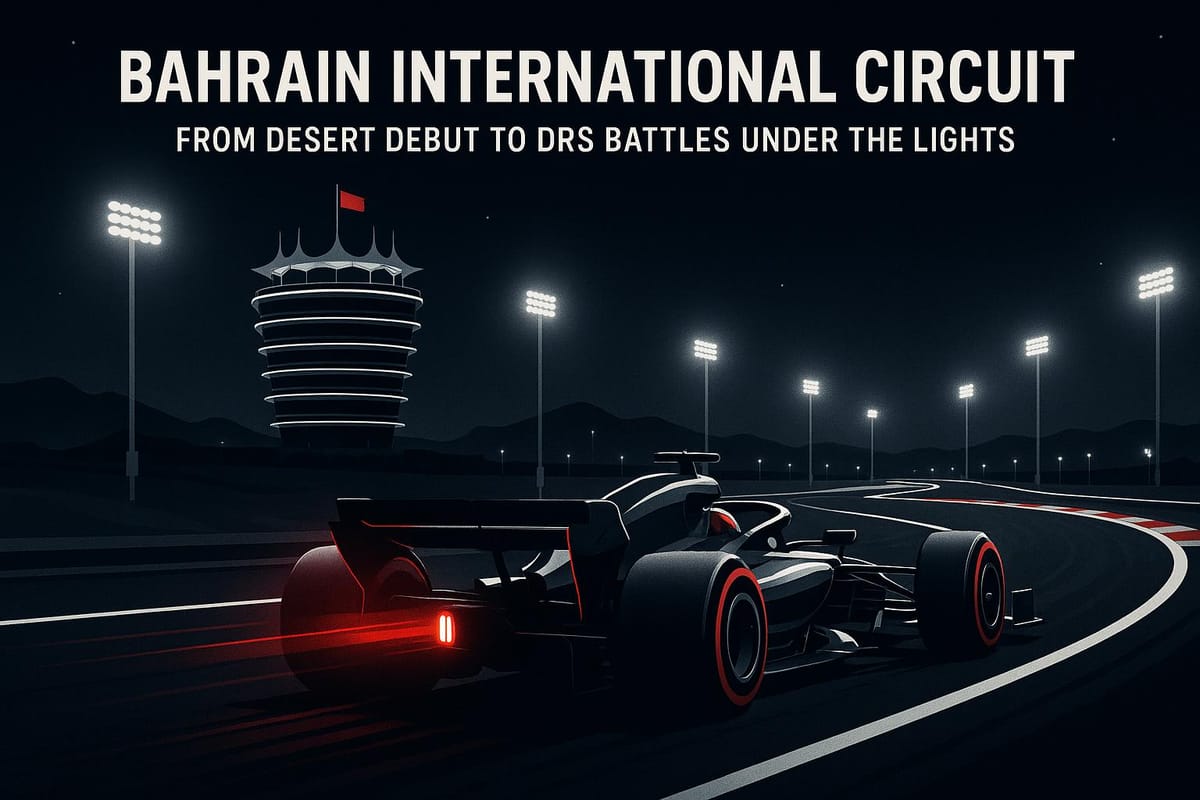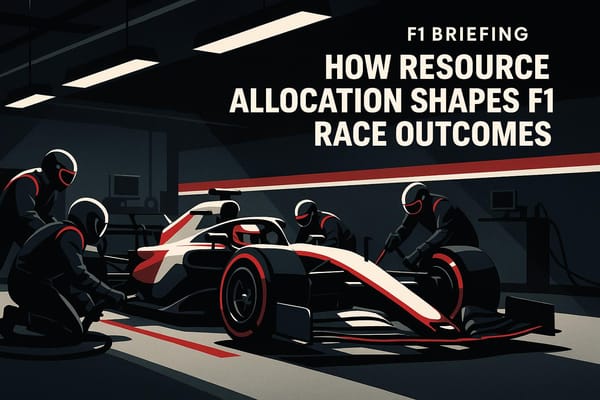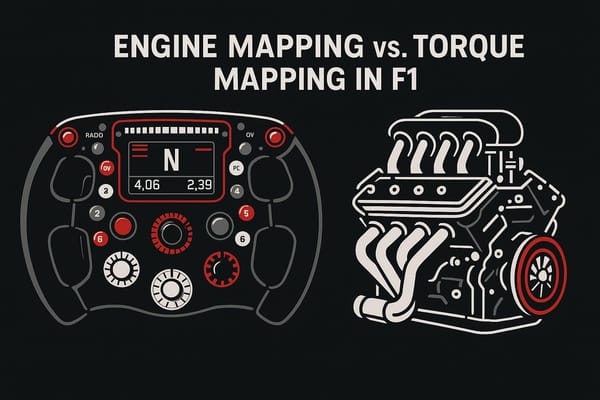Bahrain International Circuit: From Desert Debut to DRS Battles Under the Lights
Explore the evolution of the Bahrain International Circuit, its impact on Formula One, and the challenges of racing in a desert environment.

The Bahrain International Circuit has been a key player in Formula One since its debut in 2004. Here’s what you need to know:
- First Middle East F1 Race: Opened in 2004, built in 16 months for $150M.
- Economic Impact: Contributes 2.76% to Bahrain's GDP, generating $350M net annually.
- Night Racing: Introduced in 2014, adding a new dimension to the races.
- Track Layouts: Features multiple configurations like the Original GP Circuit, Endurance Layout, and Outer Circuit.
- Tire and Strategy Challenges: Known for its abrasive surface and sand exposure, making tire management critical.
- Sustainability Efforts: Powered by a 3.5MW solar farm, aligned with F1’s goal of net-zero carbon by 2030.
With a contract extending to 2036, the Bahrain International Circuit remains a cornerstone of F1, blending technical challenges with cutting-edge updates.
A-Z GUIDE to the BAHRAIN F1 GRAND PRIX
Track Design and Layout Changes
The Bahrain International Circuit is a fascinating blend of cutting-edge design and thrilling racing action. Since its debut in 2004, the track has seen several updates aimed at enhancing competition while staying true to its desert-inspired roots. Let’s start with the vision behind its original design.
Hermann Tilke's Original Track Design
Hermann Tilke's 5.412-kilometer layout was more than just a race track - it was a nod to Bahrain's rich heritage. By incorporating elements of local culture and addressing the unique challenges posed by desert conditions, Tilke created a circuit that balanced functionality with character.
The original design focused on:
- Key Overtaking Zones: Long straights leading into heavy braking points, particularly at turns one and four, to encourage passing opportunities.
- Challenging Corners: A combination of high-speed and low-speed sections that tested drivers' technical abilities.
- World-Class Facilities: With $150 million invested, the circuit boasted infrastructure that met the highest global standards.
Circuit Layouts: 2004–Present
The Bahrain International Circuit is known for its adaptability, offering multiple configurations tailored to different racing needs. Here's a quick look at the main layouts:
| Layout | Length | Period Used | Key Characteristics |
|---|---|---|---|
| Original GP Circuit | 5.412 km | 2004–2009, 2011–present | A balanced mix of straights and technical sections. |
| Endurance Layout | 6.299 km | 2010 | Adds nearly a kilometer with tight, narrow corners. |
| Outer Circuit | 3.543 km | 2020 Special Events | Shorter laps with more overtaking opportunities. |
Each configuration has influenced racing strategies, especially in terms of overtaking and tire management. These changes have solidified Bahrain's reputation as a venue that pushes the boundaries of modern F1 tactics.
"One of the major tasks we undertook to mark this milestone was implementing changes to our FIA approved track layout, giving the participating teams of the Bahrain Grand Prix a completely new challenge".
DRS Zones and Racing Lines
The circuit's evolution didn’t stop with layout changes. Adjustments to DRS (Drag Reduction System) zones have played a critical role in shaping race outcomes. Key updates include:
- 2019 Update: A third DRS zone was added on the first long straight following the opening corners, offering new overtaking opportunities.
- 2023 Refinement: The main DRS zone saw its activation point moved from 170 meters to 250 meters after turn 15, creating a more strategic use of DRS.
These updates were especially impactful during the 2022 Bahrain Grand Prix, where Max Verstappen and Charles Leclerc engaged in a thrilling DRS-fueled battle, trading the lead multiple times. Such dynamic moments underscore the circuit's dedication to staying at the forefront of racing innovation.
"The loop was completed in 2006 as part of the built-in evolution of the venue for competitors and fans...it is the perfect time to evolve the circuit with this new challenge and new overtaking opportunities."
- Zayed R. Alzayani, Chairman of the Bahrain International Circuit
Track Conditions and Performance Factors
3 Sectors: Technical Requirements
The Bahrain International Circuit is divided into three distinct sectors, each presenting unique technical challenges for both drivers and cars. Here's what makes these sections so demanding:
- Turn 1-4 Complex: This area demands precise control over heavy braking zones. Drivers must carefully manage brake temperatures and traction to navigate these corners effectively.
- Hairpin Sections: Turns 8 and 10 are especially tough on rear tires, putting them under considerable stress due to the sharp turns and braking demands.
- Limited Recovery Time: The short straights between technical sections leave little time for tires to reheat, adding another layer of difficulty.
The 2022 regulations have only amplified these challenges. Cars now rely on less mechanical grip in slower corners while benefiting from increased aerodynamic grip in faster ones. Additionally, the stiffer suspension setups required for ground-effect aerodynamics make navigating the circuit even trickier. These factors highlight how the track's layout and surface conditions test the limits of both machinery and strategy.
Surface Grip and Tire Wear
The Bahrain International Circuit is notorious for its abrasive surface, largely due to the high granite content in its asphalt. This creates one of the most challenging environments for tire management in Formula One. Here's a breakdown of the key surface factors and their impact:
| Factor | Impact | Strategic Consideration |
|---|---|---|
| Rough Asphalt | Accelerates tire wear | Teams often adopt multi-stop strategies. |
| Sand Exposure | Reduces grip levels | Drivers must take a conservative approach in affected areas. |
| Traction Zones | Causes high rear tire degradation | Power application needs to be carefully managed. |
During the 2023 Bahrain Grand Prix, these challenges were front and center. Most teams opted for two-stop strategies to combat rear tire degradation while maintaining competitive lap times. Beyond the abrasive surface, fluctuating temperatures added another layer of complexity, especially with the race taking place under floodlights.
Temperature Impact on Race Setup
Night racing at Bahrain introduces its own unique set of challenges, with temperature management becoming a critical aspect of race strategy. Teams must navigate several issues:
- Practice vs. Race Conditions: Since two practice sessions occur during the hotter daytime hours, teams face difficulties optimizing setups for the cooler nighttime conditions.
- Brake Management: Enclosed wheel covers trap heat, making it harder to keep brakes cool during the race.
- Variable Grip Levels: Sand carried by the wind can reduce grip, further complicating car handling.
These challenges were on full display during the 2022 Bahrain Grand Prix. Max Verstappen, for instance, struggled with brake temperature issues as early as Lap 3. To manage the problem, he had to resort to lift-and-coast tactics, which ultimately compromised his ability to fight for the lead.
"As everyone else struggled to balance the problems caused by tyres and brakes around Bahrain's demanding Sakhir circuit, Charles Leclerc and Carlos Sainz delivered Ferrari an immaculate one-two."
– Mark Hughes, Special Contributor, Formula 1
Key Races and Major Events
2004-2013: First Decade Highlights
In 2004, the Bahrain Grand Prix brought Formula One to the Middle East for the first time. Michael Schumacher stole the show, claiming pole position with a lap time of 1:30.139 and setting the fastest lap of the race at 1:30.252 in his Ferrari F2004. The event attracted 68,000 fans, witnessing Ferrari's dominant 1-2 finish, with Rubens Barrichello securing second place. Jenson Button, driving for BAR-Honda, crossed the line in third, trailing Schumacher by 26.687 seconds. Meanwhile, Fernando Alonso delivered a standout performance, climbing from 16th to sixth despite difficult track conditions.
"It is possible that the cloudy skies and the dust on the track worked a bit in favour of our package".
These early years laid the groundwork for a new era of racing in the region.
2014-Present: Modern Era Battles
The Bahrain International Circuit made a bold move in 2014 by introducing night racing. This change not only enhanced the visual appeal with cooler evening temperatures and better track visibility but also added complexity to race strategies, particularly in managing tire performance.
"There can be no better way for us to mark our 10th anniversary in F1".
2020 Sakhir Grand Prix: Outer Circuit Layout
In 2020, the circuit continued to push boundaries with the introduction of a fresh layout for the Sakhir Grand Prix. This shorter, 3.543 km (2.20 mi) configuration offered a new challenge, diverging after turns 1-3 into a series of high-speed sections before rejoining at turn 13. George Russell set a blistering lap record of 55.404 seconds on this layout. The 87-lap format added an extra layer of intensity to the competition.
| Track Configuration | Length | Lap Record | Total Race Laps |
|---|---|---|---|
| Standard Circuit | 5.412 km (3.36 mi) | 1:30.252 (2004) | 57 |
| Outer Layout | 3.543 km (2.20 mi) | 55.404 (2020) | 87 |
Circuit Updates and Development Plans
2026 Power Unit Requirements
The Bahrain International Circuit is preparing for major updates to meet Formula One's ambitious 2026 power unit regulations. These new standards will retain the V6 engine design but significantly increase electrical output to 350 kW - nearly three times the current level. To handle this shift, the circuit must upgrade its infrastructure to safely manage high-voltage equipment. Additionally, the regulations aim to cut fuel consumption by 30%, reducing it from 100kg to 70kg per race, all while improving overall efficiency. A key feature of the new power units is their exclusive use of fully sustainable fuels. These changes are part of the circuit's broader commitment to sustainability.
"The FIA continues to push forward on innovation and sustainability – across our entire motor sport portfolio – the 2026 Formula 1 Power Unit Regulations are the most high-profile example of that mission."
- FIA President Mohammed Ben Sulayem
Energy and Resource Management
The circuit's preparations for the 2026 regulations go hand-in-hand with its energy and resource management initiatives. A newly installed 3.5MW solar farm now generates enough clean energy to meet all of Formula 1's needs year-round. This solar project, completed before the 2022 season, represents the first phase of a long-term sustainability plan.
"Today's commitment is an important part of our broader sustainability aims as a circuit and supports F1's own target to be net carbon neutral by 2030. This initiative will not only make our F1 race a cleaner and greener event in the future, but will encourage other large-scale events to make the move to sustainable energy, and inspire sports fans to embrace change."
- Shaikh Salman bin Isa Al Khalifa, Chief Executive of the Bahrain International Circuit
These efforts align closely with Formula 1's overall environmental strategy.
"We are proud of the efforts by the Bahrain International Circuit to make the race more sustainable and their bigger plans for the coming years. This perfectly aligns to our own strategy to be Net Zero Carbon as a sport by 2030."
- Stefano Domenicali, President and CEO of Formula 1
| Sustainability Milestone | Target/Achievement |
|---|---|
| Solar Farm Capacity | 3.5MW |
| F1 Weekend Energy Source | 100% Sustainable |
| 2026 Race Fuel Target | 70kg (30% reduction) |
| Carbon Emissions Goal | Net Zero by 2030 |
Conclusion: Bahrain's Place in F1
The Bahrain International Circuit represents Formula One's bold step into the Middle East. Since hosting its first race in 2004, it has become a key venue in the sport's modern era. With an investment of US$150 million, what was once a barren desert has been transformed into a premier racing destination.
The numbers speak volumes about its success. On race day, 37,000 fans fill the stands, with a total of 100,000 attending over the weekend. These figures highlight not just the circuit's growth but also the increasing passion for F1 in the region.
"Twenty years ago, we began our journey in motorsport, hosting the first ever Formula 1 race in the Middle East. Today, we are deeply proud to celebrate our milestone with an incredible weekend of racing and entertainment. Our anniversary celebrations have given us a chance to reflect on our 20 years of racing history and the contribution we have made to the sport, but also look forwards to the future with great confidence." - Sheikh Salman bin Isa Al Khalifa, Chief Executive of Bahrain International Circuit
The circuit's design and facilities reflect its forward-thinking approach. With multiple configurations like the Grand Prix, Outer, and Endurance layouts, it adapts seamlessly to the sport's changing needs. Its prime location and reliable weather make it the go-to venue for pre-season testing and the season opener.
Bahrain has also been at the forefront of innovation, from introducing night races in 2014 to embracing sustainability measures. These efforts ensure the circuit remains relevant and progressive. With a contract extending to 2036, Bahrain is set to continue as a hub for technological advancements and a challenging stage for teams and drivers alike.
| Milestones | Year | Impact |
|---|---|---|
| First Middle East F1 Race | 2004 | Opened the door for F1 in the region |
| FIA Institute Excellence Award | 2007 | Recognized for safety and technological standards |
| Night Racing Implementation | 2014 | Boosted global viewership and fan experience |
| Record Weekend Attendance | 2024 | Drew 100,000 spectators over the race weekend |
FAQs
How has night racing at the Bahrain International Circuit changed race strategies and results?
The transition to night racing at the Bahrain International Circuit, introduced in 2014, has reshaped how teams approach the race. With cooler evening temperatures, tire wear is less severe than during daytime events. This allows teams to stretch tire performance over longer stints, though the track's abrasive surface still makes two-stop strategies a frequent choice.
The inclusion of three DRS zones has added a layer of complexity to overtaking, making race pace and timing crucial during pivotal moments. Under the night sky, the emphasis has shifted from starting grid positions to adaptability during the race and smart tire management. These factors have produced intense, action-packed battles, solidifying Bahrain’s status as one of Formula One’s most thrilling circuits.
What challenges do Formula One teams face at the Bahrain International Circuit due to its desert environment and abrasive track surface?
The Bahrain International Circuit poses distinct challenges for Formula One teams. Its abrasive track surface significantly increases tire wear, making smart tire management a key part of race strategies. On top of that, the desert environment introduces unpredictable elements like strong winds and sandstorms, which can disrupt visibility and even affect car performance.
Adding to the difficulty are the high daytime temperatures, which not only accelerate tire degradation but also put extra pressure on engine cooling systems. These combined factors make the Bahrain Grand Prix one of the most demanding races for teams to navigate strategically.
What is the Bahrain International Circuit doing to support Formula 1's sustainability goals, and are there any future plans in this area?
Bahrain International Circuit's Commitment to Sustainability
The Bahrain International Circuit (BIC) is taking meaningful steps to align with Formula 1's sustainability goals. Since 2022, the circuit has relied on sustainable energy sources to power the Bahrain Grand Prix. Even more ambitiously, they plan to extend this approach to meet their energy demands throughout the entire year.
The BIC is also tackling waste reduction with practical measures. For instance, they’ve incorporated upcycled materials into seating areas and eliminated single-use plastics at food and beverage stands. These changes not only minimize waste but also set an example for eco-conscious practices in motorsport.
On top of that, the circuit is focused on reducing its carbon footprint and boosting energy efficiency. These initiatives reflect Formula 1's broader commitment to sustainability, keeping the BIC at the forefront of environmentally responsible motorsport innovation.
Related posts
- Albert Park Uncovered: The History, Evolution, and Challenges of the Australian Grand Prix Circuit
- Shanghai International Circuit: A Technical Masterpiece Behind the Chinese Grand Prix
- Jeddah Corniche Circuit: The High-Speed Street Track Redefining Night Racing in Saudi Arabia
- Miami International Autodrome: The Newest Showstopper in F1’s American Dream




